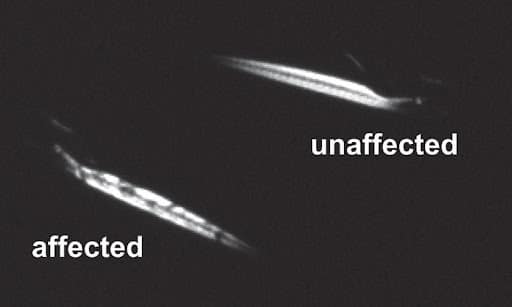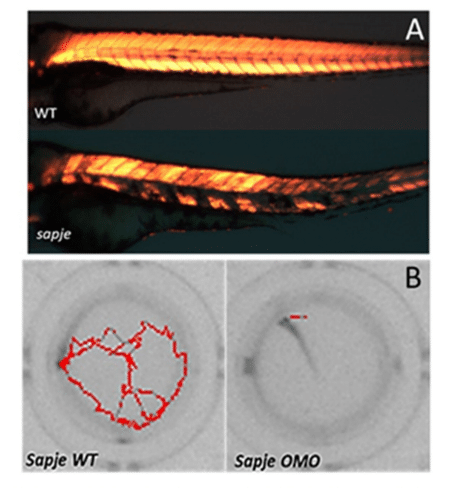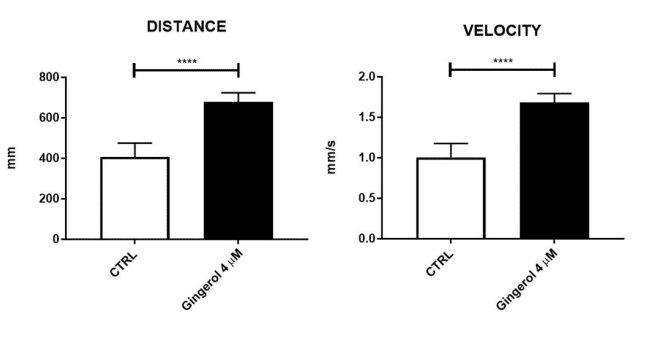Summary
In recent years there has been growing interest in science’s ability to improve humans’ quality of life – in particular research aimed at identifying medicines and supplements to better the time that we have. This is particularly pertinent for people suffering from chronic conditions, and disorders with no known cure. One example of a condition which may benefit from dietary supplements is Duchenne muscular dystrophy (DMD), an inherited genetic disorder that causes progressive muscle degeneration. Inspired by results seen in real-world clinical practice, Licitra et al. (2021), used a zebrafish model organism to explore the ability for gingerol to mitigate dystrophic symptoms and improve DMD patients’ quality of life. This article will discuss their findings, and how studies like this present an exciting and promising future for currently incurable diseases.

Image 1. Example of utilizing a zebrafish model for research into human muscular dystrophies: identification of dystrophic zebrafish larvae using a birefringence assay (Widrick et al., 2019).

Image 2. Birefringence assay and locomotion tracking. A) Birefringence assay on wild‐type‐like non‐dystrophic heterozygous (WT) and on dystrophic homozygous sapje larvae, at 4 days post‐fertilization; B) Example of locomotion tracking of WT and homozygous (OMO) sapje larvae (Licitra et al. (2021).
Have you ever been diagnosed with anemia, taken an iron supplement, and felt your fatigue fade away? Or sipped peppermint tea after a large meal and felt your upset stomach relax? Antidotal experiences like these exemplify dietary supplements’ ability to change how we feel. For those suffering from chronic conditions and inheritable diseases such as Duchenne muscular dystrophy (DMD), small improvements in day-to-day functions can be life-changing. Recently, Licitra et al. (2021) took note of caretakers’ reports that the diets of DMD-sufferers could impact the severity of their symptoms: certain foods would improve muscle strength.
More about: DMDDMD is a rare inherited disorder that is caused by a gene mutation on the X chromosome. Mainly seen in boys, DMD occurs in 1 in 3,500-5,000 people. Symptoms include weakened muscles leading to frequenting falls and difficulty standing and running, as well as learning disabilities. While physical therapy and steroids can help, there is no cure. The average life expectancy of those suffering from DMD is 29.9 years. |
More about: the zebrafish model & muscular dystrophiesZebrafish are an increasingly utilized model organism thanks to their small size (2.5-4cm), short life span (90 days maturation), and large brood size (200-300 eggs per week). Zebrafish are particularly useful for studying human muscle diseases as these fish have strikingly similar skeletal muscle to humans along with conserved genetic, molecular, and histological features. There are established zebrafish models for numerous human muscle disorders such as: DMD, Laminin α2-associated muscular dystrophy, facioscapulohumeral muscular dystrophy, Ullrich CMD, and X-linked myotubular myopathy. |
To investigate further, Licitra et al. (2021) selected 23 molecules to be screened using a zebrafish model. The molecules were chosen based on their anti-inflammatory or antioxidant actions on muscle tissue. Four of the tested molecules (gingerol, resveratrol, flavokawain A, and pterostilbene) appeared promising, but only gingerol, a constituent of fresh ginger, was statistically significant – improving zebrafish locomotion.
Upon these findings, Licitra et al. (2021) performed an additional trial, focused on the effect of gingerol on locomotion in sapje larvae [Figure 3]. Their findings confirmed the initial results: gingerol greatly improved zebrafish locomotion.

Figure 3. Illustrating the effects of Gingerol on locomotion (distance and velocity) of untreated (CTRL n = 103) and treated with Gingerol 4 μM (n = 128), dystrophic homozygous sapje larvae at 5 days post‐fertilization **** p ≤ 0.0001
Furthermore, Licitra et al. (2021)’s findings support the proposal that Hmox1 could be a novel target for dystrophic symptoms. Previously, sildenafil, whose mechanism of action is believed to affect the Hmox1 pathway, was shown to improve location and survival in zebrafish larvae, and, when Licitra et al. (2021) conducted a qPCR gene analysis, they found that the gingerol-treated larvae showed increased expression of Hmox1. Taken together, these findings led Licitra et al. (2021) to suggest gingerol as a dietary supplement for DMD.
This study is encouraging as it shows how quickly a well-executed study can affect change in people’s daily lives: the results encourage the use of gingerol as a dietary supplement now while the more laborious nutrapharma therapy studies are underway. Thus, this study highlights the benefit of using zebrafish as a ‘first level’ model organism to conduct studies that can later be replicated in mammalian models and humans. So, don’t underestimate common spices, they may just relieve your next injury and help cure – or at least alleviate – chronic pain.
References
- Licitra, R., Marchese, M., Brogi, L., Fronte, B., Pitto, L., & Santorelli, F. M. (2021). Nutraceutical Screening in a Zebrafish Model of Muscular Dystrophy: Gingerol as a Possible Food Aid. Nutrients, 13(3), 998. https://doi.org/10.3390/nu13030998
- Broomfield, J.Hill, M., Guglieri, M., Crowther, M., Abrams, K. (2021). Life Expectancy in Duchenne Muscular Dystrophy Reproduced Individual Patient Data Meta-analysis Neurology, 97 (23) e2304-e2314; DOI: 10.1212/WNL.0000000000012910
- Fabian L and Dowling JJ (2020) Zebrafish Models of LAMA2-Related Congenital Muscular Dystrophy (MDC1A). Front. Mol. Neurosci. 13:122. doi: 10.3389/fnmol.2020.00122
- Widrick, Jeffrey J. et al. ‘Discovery of Novel Therapeutics for Muscular Dystrophies Using Zebrafish Phenotypic Screens’. 1 Jan. 2019 : 271 – 287.



